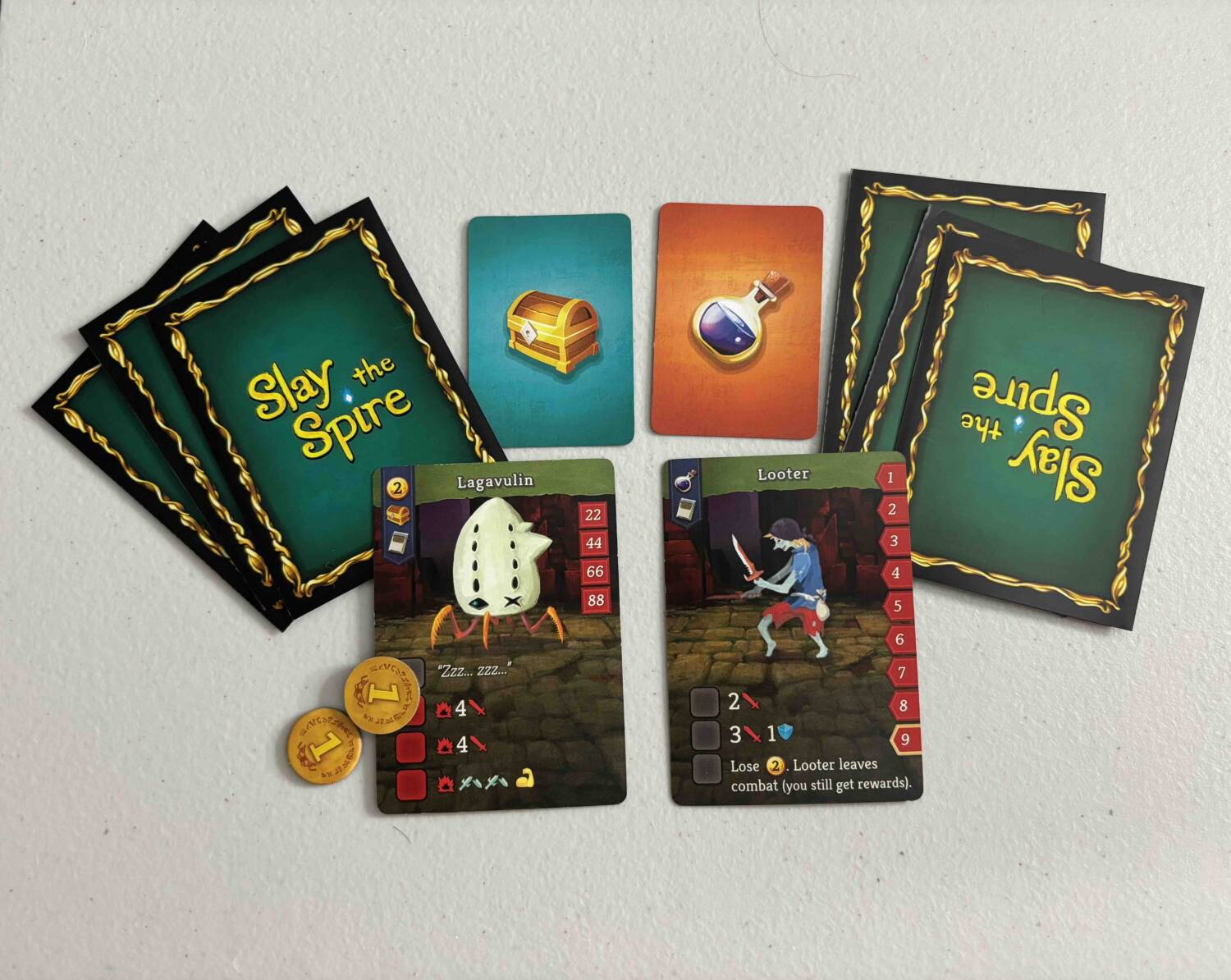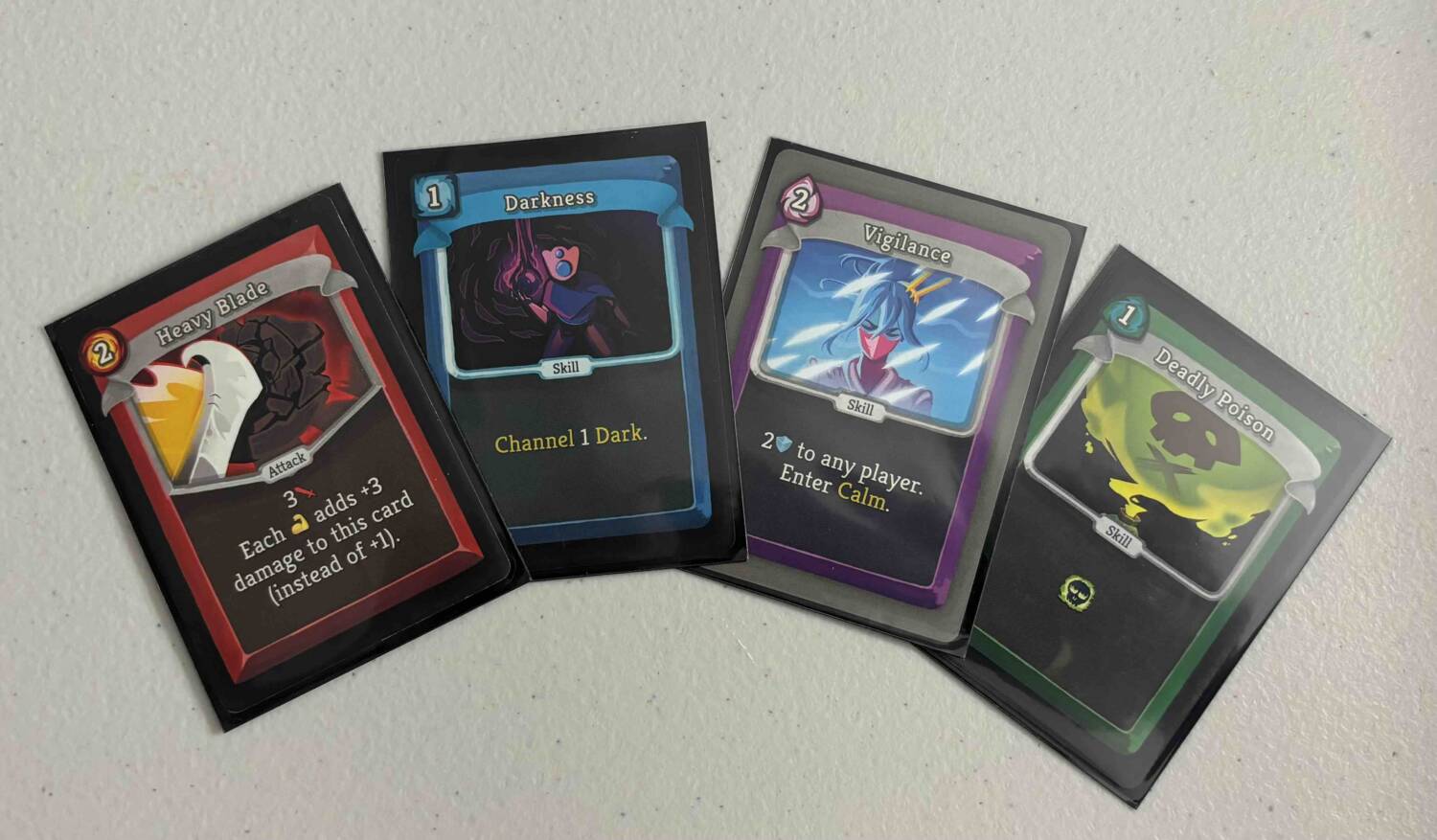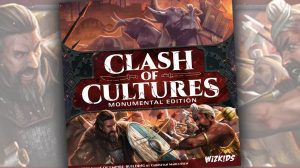Slay the Spire is a rogue-like deck-building video game that burst onto the scene in 2019 to great acclaim. Initially launched on Steam, it was an instant critical darling that soon expanded to both console and mobile platforms. While it wasn’t the first deck-building rogue-like game—Dream Quest and Hand of Fate come to mind—it still stands as the pinnacle of the genre that it helped to take mainstream, spawning many imitators but no true challengers to the throne. I’ve personally sunk at least 500 hours across multiple platforms, enthralled by its difficult but addictive gameplay.
When I heard that a board game version of Slay the Spire was being made, I was a little surprised. Not surprised that people were cashing in on the popularity of a mega-hit and the growing board game hobby. I was surprised because Slay the Spire already feels like a board game in digital form. It has a pretty standard deck-building format. Start with a 10-card deck of basic cards, draw five cards, take actions, repeat and reshuffle as necessary. Throughout the course of the game, you’ll be adding cards to the deck, perhaps removing some of the weaker starting cards, trying to optimize that card deck engine to engineer powerful turns that hopefully translate to winning.
Granted, Slay the Spire super-sizes the format by adding in a map-based rogue-like progression system, complete with standard and elite enemy encounters, shops, campfires to rest or upgrade your cards, ultimately leading to challenging boss fights with sizable rewards. Still, it felt to me like a board game version of a digital board game was both unnecessary and impractical, particularly given the amount of math and bookkeeping that the videogame does for you. I won’t spoil my final review score here, but suffice to say, boy was I wrong.
Taking to the Table
Slay the Spire: The Board Game takes the beloved video game and translates it to a multiplayer cooperative tabletop experience. The gameplay is basically the same as the video game, but with some key changes that I’ll get into. For now let’s talk about the basic gameplay, for anyone unfamiliar with the original video game.
The basic idea is that you’re going up what is effectively a dungeon path, fighting enemies along the way, while trying to reach the final boss without dying. It’s what is known as a rogue-like game. While the true definition of what a ‘rogue-like’ game is debatable, they tend to share a few qualities. Game layouts are randomly generated to some extent, players’ actions are usually turn-based, generally in a fantasy setting, there is some element of ascending a given path, and upon death players go all the way back down to the bottom and must restart from scratch. Each try is generally referred to as a run.
Slay the Spire: The Board Game uses a game board to show the player traversal from start to ultimate victory—or more likely, death. The team starts at the bottom of the board, traversing their chosen path(s), stopping at each “room,” all the way to either death or the top of the board where the boss awaits. Additionally, there are three Acts that get progressively harder. Players can stop after the first boss and call it a win, or keep climbing and press on through the next Act, keeping the same deck and any items gained in the previous one. Don’t forget, though, if you die, you lose everything and have to restart all the way back at the bottom of Act 1.

Slay the Spire: The Board Game handles the procedurally generated element of the original in a clever way. Some spots are permanently set, while others are created by a collection of randomized tokens, either light or dark colored. Light colored ones are generally the positive and harmless rooms, like shops or campfires, while the dark colored tokens generally mean monster encounters, either standard baddies or one of the more challenging elite monsters. During setup, you shuffle the tokens and lay them all out face down, then reveal, creating a board that is part randomized, but still makes sure that you have some preset rooms.

After the starting encounter, players are free to choose which path to take upwards. More monster encounters can be more difficult, but fighting monsters is primarily how you get new and better cards in your deck. Just like the video game, you’ll get to choose between three cards to add to your deck, drawn from your own personal card reward deck. Common cards have a gray banner, while Uncommons have a blue banner. You may even get lucky enough to draw the “Golden Ticket” card, which lets you draw a card from the powerful “Rare Rewards” gold-bannered card deck.

Monsters can also reward you with coins, potions—various one-time use bonuses—or even relics, lasting benefits that generally stay with you throughout the rest of the run. Elite monsters are more challenging fights, but provide higher and better rewards.

Shops will allow you to spend your hard-earned coins to buy a random assortment of potions, relics, and new cards. You can even pay to remove a card from your deck, for those looking to get rid of the basic starter cards or potential curse cards that may find their way into your deck. Slay the Spire: The Board Game represents this using a separate side board with designated locations, complete with one spot designated as “on sale,” reducing the cost by 1.

Campfires allow you to either rest or upgrade one card from your player deck. The sticky wicket here is that you can’t do both. Resting restores 3 hit points (HP), which is a significant amount given your starting HP is most likely a 9. This is also quite important considering that players don’t automatically go back up to full health after each combat. Alternatively, you can choose a card in your deck to upgrade. Each card has a basic version and an upgraded version, generally a stronger version of the same action. For example, your basic Strike card with its Attack 1 could now become an Attack 2. Slay the Spire: The Board Game handles the upgrade in a clever and simplistic way. All the cards are double-sided and sleeved. To upgrade a card, you simply take the card out of the sleeve and flip it over to the upgraded side, represented by the different color title text.

The Question Mark tokens represent events drawn from a random event deck. These usually require each player to choose between a few options that are generally good for the players. Often there is both a ‘good’ option, and a ‘great’ option, but the ‘great’ options come with drawbacks.

If your party does well enough to reach the top, you fight a boss. Bosses are tough enemies that are predetermined at setup by a die roll. They have higher hit-point pools and deal greater damage, but also yield the best rewards should you continue to keep playing.

Beating Up Baddies
The core of the game is in beating up monsters. In a room designated with a standard or elite monster encounter, you’ll draw a monster to fight from the top of their respective decks. Each player is assigned a particular row, and a monster is drawn for each in a standard encounter. In the elite encounter only the top monster is drawn, which usually attacks all rows simultaneously.

Some monsters will summon other baddies to fight with them, indicated by the red text at the bottom of the card. Drawn from a separate summons deck, these will generally go into the same row as the summoner.

Going a Round
At the start of the round, you roll a die, which can determine both monster actions and activation of special relics. Players resolve any applicable start of turn abilities in the order they choose, then take their turns. Unlike most deck-building games, there is no set player turn structure. Players take actions by playing cards in whatever order they want to, spending energy as required by the specific card to do so. You only start with 3 Energy, so choosing which cards to play from your hand of 5 cards is key. As you might expect, some of the more powerful cards cost more to play.
Cards come in three types: Attack, Skill, Power
Attack cards as you might expect let you attack the monster(s). When you attack, you can choose any monster in any row.
Skill cards include such actions as adding Block, drawing more cards, or even applying various status effects that can help you in the fight.
Power cards grant you lasting bonuses that stay out in front of you through the duration of the fight.

When all players have either exhausted all their energy or just choose not to play any more cards, the monsters activate. Each monster will target the player in their current row, although some of the attacks can deal damage to the entire party if designated with the red fire symbol. Some monsters have a preset order of actions that they will always take, trackable by a red cube. Others have randomized actions that are determined by the die you rolled at the beginning of the round.

Managing your HP, Energy, and Block are key to survival and success. Each round your Energy goes back up to the starting point, but your Block resets back to zero. This is where the multiplayer element really shines. While you can attack any monster on any row with an attack card, only some skill cards let you give Block to other players. This leads to constant cooperation and coordination of attacks and skills, because if any player’s health goes down to zero, it’s game over. Back to the bottom of the spire to start again from scratch. Add in the fact that HP doesn’t fully regenerate after each combat and you find yourself working as a team to guarantee everyone’s safety, sometimes sacrificing that extra cool combo you’ve been planning to help teammates not get totally walloped.
Like the original video game, there are four available characters to play. Each one is remarkably different. Everyone starts with some basic Strikes and Defends in their deck, but that’s where the similarities end. Each character has their own style, their own strategies, even their own card rewards deck.  For example, the Ironclad is all about building up strength and dealing heavy damage, while the Defect channels magic orbs that it can evoke to do damage or gain Block. The Silent uses sneaky things like poison and shivs, while the Watcher can switch back and forth between Angry and Calm modes, each with its own benefits and drawbacks.
For example, the Ironclad is all about building up strength and dealing heavy damage, while the Defect channels magic orbs that it can evoke to do damage or gain Block. The Silent uses sneaky things like poison and shivs, while the Watcher can switch back and forth between Angry and Calm modes, each with its own benefits and drawbacks.

From the Screen to the Table
I mentioned earlier that one of the things I was worried about was how the inherent math and bookkeeping complexities would translate to the tabletop experience. With all the different cards, relics, enemy moves, etc. I expected Slay the Spire: The Board Game to be a convoluted, bloated mess. To be fair, it very well could have been. A direct port of every card and relic ability would have meant a ton of calculations, item and ability tracking, and a serious mental overload. Fortunately, the designers must have seen this coming too and decided to scale down everything to its most basic format, but without losing the purpose or feel of each element. This is accomplished in two ways. First, they’ve minimized the math. For instance, in the digital version, the basic Strike does 6 Damage while Defend gains 5 Block. In Slay the Spire: The Board Game, both are reduced to the much more manageable value of 1. An upgraded Strike in the digital game deals 9 Damage: the board game deals 2.

Secondly, and more impressively, they’ve bypassed a lot of the tracking. Basically, the designers have made it so that you don’t have to remember anything. For instance, in the video game, the effect of poison on a monster would drop sequentially over each turn, in the board game it simply takes as much damage as there are tokens on it. Instead of the monster taking 50% more damage on every attack when it has the Vulnerable status effect, Slay the Spire: The Board Game simply has you add a Vulnerable token. The next attack does double-damage, then the token goes away. Easy peasy, break their knees-y.

Take for example the Happy Flower relic. In the video game it gives you an extra energy every three turns. Instead of having to continue to track that, Slay the Spire: The Board Game simply gives you an energy any time you roll a 3 or 4 at the start of a round. Statistically, it’s likely to be the same effective benefit, but you don’t have to remember as much.

It’s the subtle but effective changes like this that shows the designers were as focused on making this game a good board game experience as they were making it feel true to the source material. Card abilities, monster actions, even event cards have all been tweaked in such a way that veteran spire-slayers can say, “I recognize that card. Ooh, that’s clever how they did that,” while the completely uninitiated can still understand it without having to have played the video game.
But Why?
One of the main questions I hear frequently is simply Why. Why should I play the board game version when the digital game exists? Why should I go through the hassle of setting up all the cards and boards when I could just fire it up on my Nintendo Switch or iPad?
The true game-changer in this equation is the multiplayer. Adding in the cooperative element kicks the fun factor up to the top of the spire. The original video game is a purely solo experience. While you can play the board game version solo, multiplayer is where it shines. Playing with more than one of the unique characters at once is incredibly rewarding. Much of the original game is about finding broken combos within your deck that synergize to create powerful turns. Now take that fun and multiply it. So many times I found my group scheming up some truly god-level combos and setting each other up for some truly bonkers turns. Every round we’d talk through our options and how best to punch the baddies right in the face but also protect each other from incoming attacks. Since each player’s deck is unique with so many variables hand to hand, it’s difficult to fall victim to the alpha-player quarterbacking.
To Slay or Not to Slay
I’ll start my final thoughts with this caveat. There was a pretty good chance that I would like this game coming into it, given how much I loved the source material. That said, Slay the Spire: The Board Game has no business being as good as it is. The way that they’ve managed to both stay true to the original and make it work as a board game is truly mind-blowing. Everything about the original game that you love is here in the board game and even more impressively, it works! (I’m loving the added fan service of including card unlocks, Ascension levels, customized runs, even the secret boss.)
It’s not just a great version of the game; it’s a great game full stop.
Wanting to see if my internal bias was the only reason I loved the game, I played a 4p session: two of us full-on hobby gamers and spire veterans, one moderate and one relatively new gamer, both with no connection to the IP.. Aside from a few rules hiccups, everyone grokked the game fairly easily. It helped that half of us were already intimately familiar with the video game. I’m not sure a table full of Slay the Spire newbies could pick it up from the rulebook alone. In any case, I’m happy to report that we all had an absolute blast, deciding to spend the entirety of our game time going through all three acts. We’re already making plans to switch characters and go through the whole thing again.
Slay the Spire: The Board Game is quickly climbing to the top of my favorite cooperative games, and may even scale its way into my favorite games of all time. I enjoy playing it solo, even when I could just as easily play the video game. This is one of those “keep it set up on the table” games, and not just because of the lengthy tear-down time. The variable characters, decks, various challenges and unlockables keep me coming back again and again. Slay the Spire: The Board Game gets the highest recommendation for me.












Add Comment